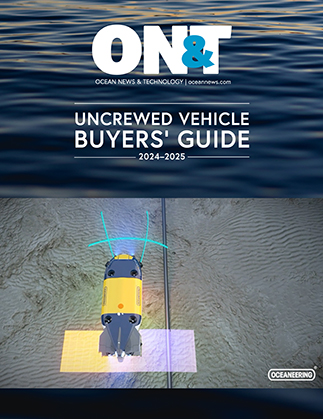The test range, which opened its doors to industry in 2022, is one of the first marine technology test ranges in the world located in tropical waters.
For the exercise, Advanced Navigation’s underwater drone, or micro-autonomous underwater vehicle (micro-AUV), Hydrus, was tasked with autonomously mapping a predefined area of the seabed in search of specific points of interest—which, in this scenario, were hidden objects intended to represent underwater mines.
NAVIGATING TROUBLED WATERS
Numerous challenges accompany a scenario of this nature. To begin, exercises of this kind typically entail significant costs and logistical complexities. Enlisting boats and highly trained specialists is not only expensive but also time-consuming. Moreover, deploying and recovering traditional AUVs necessitates the use of large equipment, such as cranes, which consumes valuable time that could otherwise be devoted to data collection.
Secondly, the operation required Hydrus to function in tropical waters, which are notoriously difficult for autonomous marine systems. Foremost, higher temperatures in tropical waters have the potential to cause robotic systems to overheat. Additionally, complex water flow and bottom topography in these regions can result in higher turbidity, causing water to become clouded with suspended sediment, reducing visibility and potentially causing thrusters to clog and seize operation.
Lastly, the simulation centred around a scenario where ensuring the safety of personnel was paramount. It focused on a situation in which a customer would deploy a drone to detect potential hazards, such as underwater mines, before advancing their vessel. Furthermore, the exercise introduced an element of unpredictability, as Hydrus had no prior knowledge of the placement of mine-like objects. This mirrored a real-world search in a hazardous and unfamiliar environment.
PURPOSE-BUILT PACKAGE
Fortunately, Hydrus was purpose-built to address these very concerns. Thanks to its compact size and autonomous capabilities, the mission could be executed with cost-efficiency and minimal logistical complexities.
To illustrate this, all the necessary equipment for this exercise could be conveniently transported in just three transit cases, each weighing less than 21 kg. Hydrus itself, weighing a mere 7 kg, can be deployed and recovered by a single individual. This obviates the need for heavy transportation, on-site storage, large vessels, cranes, or a team of specialists.
What truly distinguishes Hydrus is its ability to operate effectively within the challenging tropical waters environment, setting it apart from comparable products in the market. Being developed in Australia provided a local advantage, as Hydrus underwent extensive testing in warm tropical waters during its design phase. Additionally, its thrusters were thoughtfully designed with the challenges of suspended sediment in mind. The drone’s impellers offer a higher level of control authority than any comparable product on the market, rendering them resilient to suspended sediment and complex water flow.
USV COMPATIBLE
Regarding safety, this simulation presented an opportunity for the Advanced Navigation team to showcase a unique solution aimed at minimising risk to personnel. Typically, USBL and GNSS systems are affixed to crewed boats. However, in this exercise, Advanced Navigation’s Subsonus and GNSS Compass were integrated onto Surfbee, an autonomous uncrewed surface vessel (USV). Leveraging the autonomous capabilities of Surfbee, this setup allowed the crew to maintain a safer distance from the scouting area.
The end-to-end operation, from deploying to recovering Hydrus, took less than 30 minutes. Hydrus performed flawlessly right out of the box, requiring minimal mobilisation time and experiencing no delays. Coupled with the use of a small vessel, this efficiency allowed the team to swiftly gather the necessary data to complete the mission. In fact, due to the rapid turnaround time, the team ran the simulation two more times with each operation completed in under 30 minutes.
Notably, by repeating the simulation, the team observed that the mine-like objects had shifted positions on the seabed between each operation. This not only highlights the complex currents in tropical waters but also underscores the potential safety risks had the operation been conducted only once, as typically expected with traditional systems.
To locate the objects, Hydrus autonomously followed a predefined search pattern within a set perimeter in the water, in a path akin to mowing a lawn. While executing the search pattern, Hydrus’ camera successfully identified points of interest and captured high-accuracy imagery of the target objects.
As is customary with all simulations involving Hydrus, the data collected during this exercise will be used to train Hydrus’ AI model, enhancing its capability to pinpoint and inspect points of interest on the seabed with even greater precision and detail. Conducting more simulations will continue to enrich Hydrus’ onboard AI, improving its overall capabilities.
The successful completion of this simulation at ReefWorks validates Hydrus’ ability to provide a data collection solution that not only minimises logistical effort but also allows for rapid deployment compared to other systems. Moreover, it does not require trained specialists, keeping the overall costs minimal. This enables users to deploy Hydrus quickly, safely and cost-effectively wherever it is needed.
This story was originally featured in ON&T’s December Special Edition 2023 issue. Click here to read more.

